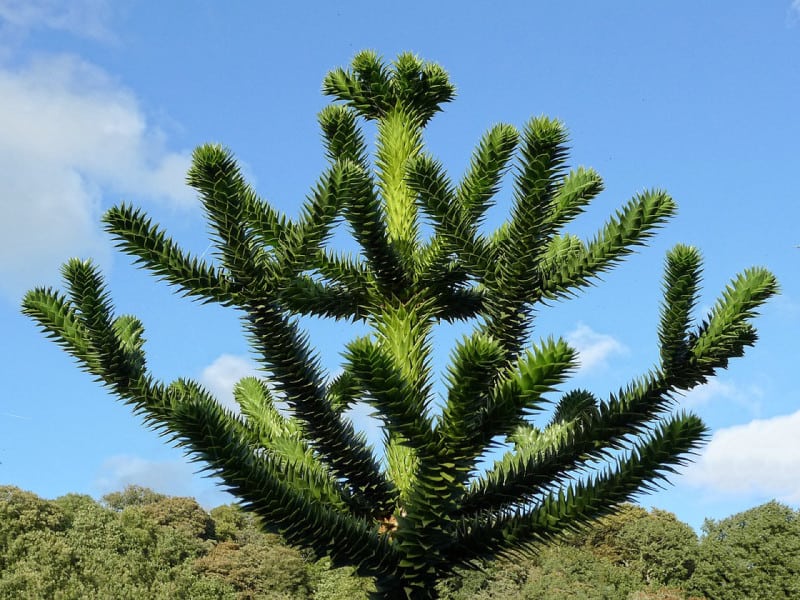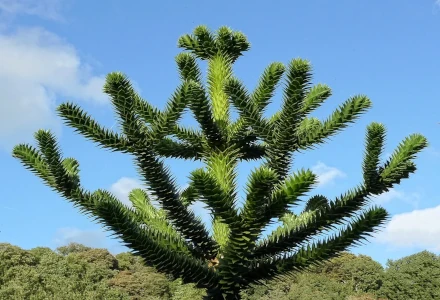
Public Domain Image
Monkey Puzzle Tree Facts
- The eye-catching term of Monkey Puzzle Tree serves as the colloquial name for the Araucaria araucana. And in many ways, the name fits perfectly. This plant species also remains an ancient one that often gets called a living fossil.
- The completely unique name for the tree also originated in the year 1850. This occurred when someone observed that it would puzzle a monkey to climb it. How that person came up with such a humorous description is just incredible.
- But, very sadly, this tree remains very rare in the wild. Though it develops as a hardy and resilient variety, its numbers inexplicably seem to be dwindling rapidly in nature. It now forms a popular garden species in some regions.
Related Articles
Kauri Tree Kentia Palm English Oak
Monkey Puzzle Tree Physical Description
The truly remarkable Monkey Puzzle Tree tree represents what experts call a dioecious species. That’s because of the fact that the cones of individual trees typically all form either male or female. This remains a surprisingly common trait among many plants.
Occasional exceptions to this principle do nevertheless sometimes occur. This impressive evergreen also ranks as a moderately large variety. In fact, specimens attain a height of as much as 130 ft (40 m), and the trunks reach 7 ft (2.14 m) in diameter.
The wind further serves as the primary pollinator for this particular species. The seed cones of the Monkey Puzzle Tree reach about 8 in (20 cm) in diameter and disintegrate upon maturity. The seeds released also reach roughly 1.6 in (4 cm) in length.
The leaves of the amazing tree also grow thick and tough. These typically also develop as roughly triangular in overall shape. This remarkable species further evolved as extremely long-lived. Some individuals measure more than 1,000 years old.
- Kingdom: Plantae
- Phylum: Pinophyta
- Class: Pinopsida
- Order: Pinales
- Family: Araucariaceae
- Genus: Auracaria
- Species: A. auracana
Public Domain Image
Monkey Puzzle Tree Distribution, Habitat, and Ecology
The Monkey Puzzle Tree evolved as endemic only to the lower slopes of the Andes Mountains in portions of Argentina and Chile, in South America. More precisely, within this limited region, the tree generally grows at altitudes above 3,300 ft (1,000 m).
Most fortunately, this species remains comparatively tolerant of diverse soil types in cultivation, compared to other trees. In point of fact, the remarkable variety of tree occurs naturally only in regions of slightly acidic volcanic soil with excellent drainage.
Its extremely unique appearance has further helped to aid in the preservation of the fabulous Monkey Puzzle Tree, albeit unintentionally. That’s due to the fact of this appearance, in addition to being fascinating, also makes it popular in gardens.
The seeds remain edible and highly nutritious for which they get widely harvested in Chile. It also holds a long-standing cultural importance within its native range. That holds true partly because of both its scarcity, and sacred status to members of the local Indigenous Peoples.
Specifically; thanks to the Mapuche Native Americans, it now holds the status of a protected species in the wild. Regrettably, the cause of its decline in the wild comes as no surprise to many people. In this, it mirrors the status of many other species.
That holds true due to the fact that this status occurs because of a loss of habitat. Unfortunately, but not surprisingly, this state exists due to human encroachment. The IUCN therefore currently lists the Monkey Puzzle Tree as Endangered on its Red List.
Species Sharing Its Range
Hoatzin Mara Jewel Caterpillar
Check out our other articles on 7 Splendid Canary Islands Species, Gray Fox, Lake Como, Sea Lamprey, Ohlone Tiger Beetle, Aldabra Giant Tortoise, Wilson’s Bird-of-paradise

